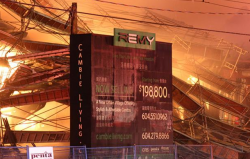Flameout in Richmond
BLOG POST posted on Mai 6, 2011 by Joseph Jones
Trying to Do It Cheap Costs Big and Could Kill
For two days running, the Vancouver Sun has rightly given a front-page lead story to the inferno that engulfed the Remy at 9388 Cambie Road in Richmond on May 3.
As the first story reports, "The [building] code was changed as part of the B.C. Wood First Act that aimed to stimulate the province's timber industry."
Irresistable aside: Isn't "B.C. Wood First Act" an impressive title for a piece of legislation? Three more zinger possibilities:
• B.C. Increase Developer Margins Act
• B.C. Clearcut Forest Faster Act
• B.C. Rebuild It All Next Generation Act
Consider the following five points:
One. This first use of the new provision for taller wooden buildings has set out to produce a lot of "affordable housing" units. (Rich Coleman won't be living in one; Bob Rennie won't be selling one; offshore investors won't be parking money in one.)
Two. Richmond jumped at being first with this type of construction — but without specifically equipping its fire department to handle tall fires!
Three. Officials put many other smaller wood dwellings at risk by this facilitation of developer and forest industry greed. — Falling ashes and embers blowing off the fire caused spot fires throughout the city … Ten other homes were damaged by the blowing embers. (May 5, Vancouver Sun)
Four. As provincial and municipal policies in British Columbia continue to widen the gap between housing haves and have-nots, and to exacerbate a growing class divide, motivations for revenge and vandalism may increase. Taller wooden construction poses heightened risks, which insurance companies may not be willing to bear at acceptable premiums. — The UK Timber Frame Association estimates that two out of three fires on construction sites are started deliberately with motives ranging from revenge, fraud, crime concealment and vandalism. (para. 3.5, p. 28 of December 2010 report on fire safety in London, England)
Five. On the environmental front (see below), it would be interesting to have a quantification on the carbon release generated by that massive combustion.
And in Vancouver …
The City of Vancouver jumped on the "tall wood" bandwagon on 21 July 2009 (see Policy Report 3). After all, what councillor could resist a report saying that developers might be able to boost their profits? Council minutes state: ADOPTED ON CONSENT. (See: Amending By-law No. 9905 to Building By-law No. 9419)
Appendix:
Following is the body of a letter that I sent to Vancouver Mayor and Council on 20 July 2009:
Unstated Assumption in Policy Report on Residential Wood Frame Buildings
At the afternoon Council meeting of July 21, 2009 you will be considering this policy report:
Building By-law Amendments to Enable Construction of Five and Six Storey Residential Wood Frame Buildings
Page 3 claims that wood construction has a lower environmental impact than light steel frame or concrete construction.
Page 5 outlines what seems to be the main agenda, cutting per square foot construction costs by 10%.
Please consider the environmental impacts of buildings that are designed to be demolished in one to two generations. The green claims made for wood construction assume that the lifespan of buildings constructed with the three materials are the same. Is this a reasonable assumption?
Further Reading
Fire safety in London (17 December 2010)
Tracy Sherlock / Laura Kane. B.C.'s first six-storey wood-frame construction goes up in flames. Vancouver Sun (5 May 2011) A1, A7
Tracy Sherlock. Concerns raised over wood-frame construction. Vancouver Sun (6 May 2011) A1, A4
Tracy Sherlock. Fire service still lacks tools to put out blazes at taller wood-frame buildings. Vancouver Sun (7 May 2011) A8
Michael Giroux. "Fire safety of wood buildings is not on trial." Vancouver Sun (26 May 2011) A15 [Spin from president of the Canadian Wood Council.]
The site for the Vancouver local of The Media Co-op has been archived and will no longer be updated. Please visit the main Media Co-op website to learn more about the organization.
